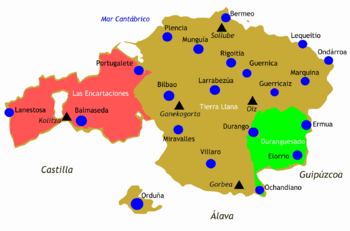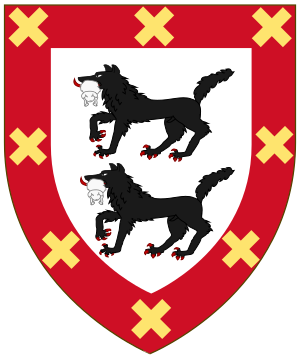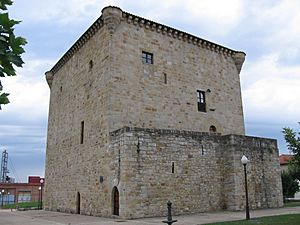Lordship of Biscay facts for kids
Quick facts for kids
Lordship of Biscay
Señorío de Vizcaya
Bizkaiko jaurerria |
|||||||
|---|---|---|---|---|---|---|---|
| c.1040–1876 | |||||||

The Lordship of Biscay and its three constituent parts
|
|||||||
| Status | Vassal first of the Kingdom of Navarre, then of the Kingdom of Castile | ||||||
| Capital | Bermeo (1476–1602) Bilbao (1602–1876) |
||||||
| Government | Lordship | ||||||
| Historical era | Middle Ages | ||||||
|
• Established
|
c.1040 | ||||||
|
• Abolition of the Juntas Generales
|
1876 | ||||||
|
|||||||
The Lordship of Biscay (Spanish: Señorío de Vizcaya, Basque: Bizkaiko jaurerria) was a special region in the Iberian Peninsula. It was located in what is now Biscay, a part of the Basque Country in Spain. From about 1040 to 1876, it was ruled by a leader called the Lord of Biscay.
This lordship was like a small country with its own rules and ways of doing things. It had its own flag for ships, special offices for trade in places like Bruges, and customs offices. For a long time, it was a vassal (meaning it had a powerful protector) first of the Kingdom of Navarre, and then of the Kingdom of Castile. From 1379, it became closely linked to the Crown of Castile, which later became the Kingdom of Spain. Even though it was part of a bigger kingdom, Biscay kept many of its own laws and traditions for centuries.
Contents
Old Stories About Biscay
Many old stories tell how the Lordship of Biscay began. These are legends, not actual history. They help us understand how people in the past thought about their origins.
The Story of Froom
One old book, written in the 1300s, tells of a man named Froom. He was said to be the brother of an English king. Froom came to Biscay with his son, Fortun Froes. They fought against the Asturians in a place called Busturia. Froom died in the battle, and his son Fortun Froes became the first Lord of Biscay.
This story also includes a magical tale about the Lady of Biscay. She was a beautiful stranger who married Lord Diego López. She had special powers and gave their son, Enheguez Guerra, a magical horse named Pardalo. This horse helped Enheguez free his father and win many battles. People believed that later lords had to make sacrifices at Busturia to thank for these events. If they didn't, a mysterious knight would attack them.
The Legend of Çuria
Another famous legend comes from a book written in 1454. It says that a man named Çuria was born in the village of Mundaka. His parents were the god Sugaar and a princess from Scotland (or other places, depending on the version). Çuria was chosen to lead the Biscayans. He led them to victory in the battle of Arrigorriaga against invaders from the Kingdom of Asturias.
Before the battle, Çuria supposedly saw two wolves carrying lambs in their mouths. This was a sign of victory. You can still see this scene on the coats of arms of the Lords of Biscay from the House of Haro. This story of Çuria later grew into the legend of Jaun Zuria, meaning "the White Lord." Some historians in the 1800s even thought he was a real person, maybe the same as Froom.
Other Mythical Lords
Later historians in the 1500s and 1600s wrote about other legendary lords. These included Hudon and his son Zeno. They were sometimes said to be related to the King of Pamplona. Like Froom and Çuria, there is no real historical proof for these figures. They are all part of the rich myths of Biscay's past.
History of the Lordship
The Lordship of Biscay has a long and interesting history, moving from being a small independent area to part of a larger kingdom.
Early Biscay
The name "Biscay" first appeared in writings in the late 800s. A chronicle from that time mentioned Biscay as a region that was "owned by its own." This meant it was not taken over by other kingdoms. In the 900s, Biscay was under the control of the Kingdom of Navarre.
The House of Haro
The Haro family played a huge role in the history of Biscay. In 1076, there was a war between the kingdoms of Navarre, León, and Castile. Íñigo López, the Lord of Biscay, helped the Leonese. In return, the Leonese kings promised to support his interests.
When Íñigo died in 1077, his son, Lope Íñiguez, became Lord of Biscay. But now, he was a vassal of the Kingdom of Castile. This was a big change! Later, his son, Diego López I de Haro, became Lord. He was defeated and likely killed in 1134 by the King of Aragón and Navarre.
For a while, Biscay went back to Navarre. But in 1173, the King of Castile attacked Navarre. A year later, Castile took over Biscay and brought the Haro family back into power. Diego López II de Haro became Lord of Biscay.
In 1176, Navarre and Castile made peace. Biscay was divided, with some parts going to Castile and others staying with Navarre. The Lords of Biscay were vassals of Navarre until 1206. After that, the Haro family became important at the Castilian court. From then on, Biscay was mainly influenced by the Kingdom of Castile, though it wasn't fully part of it yet.
Becoming Part of the Crown
The Haro family and their relatives ruled the Lordship of Biscay until 1370. At that time, the title passed to Prince Juan of Castile. He was a distant relative of the earlier Lords. Later, he became King of Castile. From that moment on, the Lordship of Biscay was connected to the Castilian kingdom. When Charles I became king, it became part of the Spanish crown.
Even though it was part of a larger kingdom, the Lordship of Biscay kept a lot of its independence. This was thanks to its special laws, called fueros. These laws gave Biscay a lot of freedom.
However, in 1874, King Alfonso XII ended the Biscayan laws and the `Juntas Generales` (General Assemblies). This brought the Lordship to an end. Since then, Biscay has been fully integrated into Spain as the province of Biscay.
The Land of Biscay
The Lordship of Biscay was made up of different types of areas, each with its own way of being governed.
Tierra Llana (Flatlands)
The Tierra Llana means "flatlands." This was mostly the countryside and farms, not protected by city walls. This area was divided into 72 elizates, which are like small districts or parishes. These elizates were grouped into six larger areas called merindades. Each elizate had a representative in the `Juntas Generales`, which was the main governing body.
- Merindad of Busturia (26 elizates): Mundaka, Sukarrieta, Busturia, Murueta, Forua, Lumo, Muxika, Arrieta, Mendata, Arratzu, Ajangiz, Ereño, Ibarrangelu, Gautegiz Arteaga, Kortezubi, Natxitua, Ispaster, Bedarona, Aulesti, Nabarniz, Gizaburuaga, Amoroto, Mendexa, Berriatua, Ziortza and Arbatzegi.
- Merindad of Markina (2 elizates): Xemein and Etxebarria.
- Merindad of Zornotza (3 elizates): Amorebieta, Etxano and Ibarruri.
- Merindad of Uribe (32 elizates): Gorozika, Barakaldo, Abando, Deusto, Begoña, Etxebarri, Galdakao, Arrigorriaga, Arrankudiaga, Lezama, Zamudio, Loiu, Sondika, Erandio, Leioa, Getxo, Berango, Sopelana, Urduliz, Barrika, Gorliz, Laukiz, Gatika, Lemoiz, Maruri, Bakio, Morga, Mungia, Gamiz, Fika, Fruiz, Meñaka and Derio.
- Merindad of Bedia (1 elizate): Lemoa.
- Merindad of Arratia (7 elizates): Igorre, Arantzazu, Artea, Zeanuri, Dima, Zeberio and Ubide.
All these areas followed the Biscayan law, or fuero. There were also five elizates that didn't belong to any merindad and didn't have a direct say in the `Juntas`. These were Alonsotegi, Arakaldo, Basauri, Zaratamo and Zollo.
Cities and Towns
There were 21 walled cities and towns in Biscay, all built during the Middle Ages. These included places like Balmaseda, Bermeo, and Bilbao. These towns had their own special laws, called carta puebla, which were different from the fueros of the Tierra Llana.
Enkarterri
The region called Enkarterri was located west of the Nervión River. It joined the Lordship in the 1200s. It was made up of 10 "republics" that had their own councils and governments. Enkarterri had its own special laws and meetings in Avellaneda. A single representative from Enkarterri would attend the main Biscayan `Juntas Generales`. Later, some of these councils got their own representatives. In 1804, the Enkarterri's own assembly was dissolved, and its councils became part of the Tierra Llana.
Durango
The area known as County of Durango (now Durangaldea) is a valley along the Ibaizabal River. It was a semi-independent region, first controlled by the Kingdom of Navarre. It had its own special laws and held its meetings in Gerediaga. In 1200, the Kingdom of Castile conquered it. In 1212, the King of Castile gave Durango to Diego López II de Haro, the Lord of Biscay. This brought Durango into the Lordship of Biscay.
How Biscay Was Governed
The Lordship of Biscay had several important political groups that helped run the territory.
Juntas Generales (General Assemblies)
The `Juntas Generales` were the most important governing body of the Lordship. All the different parts of Biscay sent representatives to these meetings. There were 72 representatives in total. Each elizate had one, and each city and town also had one.
Regimiento General (General Regiment)
This group was created in 1500. Its job was to govern Biscay when the `Juntas Generales` were not meeting. It had 12 members, called regidores, and one corregidor (a royal official). The regiment met three times a year. It eventually became known as the "Universal government of the Lordship."
There was also a Regimiento Particular (Particular Regiment), started in 1570. This group governed when the General Regiment was not available. It was made up of regidores who lived in Bilbao.
Diputación General (General Deputation)
This became the main political group in the 1700s. In 1645, the Particular Regiment changed its name to `Diputación General`. It gained more independence from the General Regiment. It had seven members: six "general members" and a president, who was the corregidor. The `Diputación` managed the `Juntas Generales` and handled military, money, road maintenance, and charity issues.
Lords of Biscay

The "Lord" of Biscay was the title given to the person who controlled the territory of Biscay.
House of Haro
- Íñigo López, 1040–1077
- Lope Íñiguez, 1077–1093, son of Íñigo López
- Diego López I the White, 1093–1124, son of Lope Íñiguez
House of Vela
- Íñigo Vélaz, 1124-c. 1131
- Ladrón Íñiguez Navarro, c. 1131–1155, son of Íñigo Vela
- Vela Ladrón, 1155–1162, son of Ladrón Íñiguez
House of Haro (restored)
- Lope Díaz I, the one from Nájera, 1162–1170, son of Diego López I
- Diego López II the Good, 1170–1214, son of Lope Díaz I
- Lope Díaz II Brave Head, 1214–1236, son of Diego López II
- Diego López III, 1236–1254, son of Lope Díaz II
- Lope Díaz III, 1254–1288, son of Diego López III
- Diego López IV the Young, 1288–1289, son of Lope Díaz III
- María Díaz I the Good, 1289–1295 (first time), daughter of Lope Díaz III
- Diego López V the Intruder, 1295–1310, son of Diego López III
- María Díaz I the Good, 1310–1322 (second time)
- Juan de Castilla y Haro the One-eyed, 1322–1326 son of María Díaz I de Haro
- María Díaz I the Good, 1326–1333, (third time)
House of Burgundy
- Alfonso XI of Castile, 1333–1334
- Juan Núñez III de Lara, 1334–1350, great-grandson of Diego López III de Haro, with his wife María Díaz II de Haro, 1334–1348, daughter of Juan de Castilla y Haro
- Nuño Díaz de Lara, 1350–1352, son of Juan Núñez de Lara and María Díaz II de Haro
- Juana de Lara, 1352–1359, daughter of Juan Núñez and María Díaz II
- Isabel de Lara, 1359–1361, daughter of Juan Núñez and María Díaz II
House of Burgundy/Trastamara
- Tello Alfonso, 1366–1370, son of Alfonso XI of Castile, husband of Juana de Lara. When he died without children, the title went to his nephew.
- John I of Castile, 1370–1379, son of Henry II of Castile and grandnephew of Biscay lord Juan Núñez III de Lara.

Painting by Francisco de Mendieta.
When John I became King of Castile in 1379, the Lordship of Biscay was joined with the Crown of Castile. Since then, the kings and queens of Castile, and later of Spain, have continued to use the title of Lord of Biscay. This includes the current king, Felipe VI of Spain.
| Tree of Lords of Biscay | |||||||||||||||||||||||||||||||||||||||||||||||||||||||||||||||||||||||||||||||||||||||||||||||||||||||||||||||||||||||||||||||||||||||||||||||||||||||||||||||||||||||||||||||||||||||||||||||||||||||||||||||||||||||||||||||||||||||||||||||||||||||||||||||||||||||||||||||||||||||||||||||||||||||||||||||||||||||||||||||||||||||||||||||||||||||||||||||||||||||||||||||||||||||||||||||||||||||||||||||||||||||||||||||||||||||||||||||||||||||||||||||||||||||||||||||||||||||||||||||||||||||||||||||||||||||||||||||||||||||||||||||||||||||||||||||||||||||||||||||||||||||||||||||||||||||||||||||||||||||||||||||||||||||||||||||||||||||||||||||||||||||||||||||||||||||||||||||||||||||||||||||||||||||||||||||||||||||||||||||||||||||||||||||||||||||||||||||||||||||||||||||||||||||||||||||||||||||||||||||||||||||||||||||||||||||||||||||||||||||||||||||||||||||||||||||||||||||||||||||||||||||||||||||||||||||||||||||||||||||||||||||||||||||||||||||||||||||||||||||||||||||||||||||||||||||||||||||||||||||
|---|---|---|---|---|---|---|---|---|---|---|---|---|---|---|---|---|---|---|---|---|---|---|---|---|---|---|---|---|---|---|---|---|---|---|---|---|---|---|---|---|---|---|---|---|---|---|---|---|---|---|---|---|---|---|---|---|---|---|---|---|---|---|---|---|---|---|---|---|---|---|---|---|---|---|---|---|---|---|---|---|---|---|---|---|---|---|---|---|---|---|---|---|---|---|---|---|---|---|---|---|---|---|---|---|---|---|---|---|---|---|---|---|---|---|---|---|---|---|---|---|---|---|---|---|---|---|---|---|---|---|---|---|---|---|---|---|---|---|---|---|---|---|---|---|---|---|---|---|---|---|---|---|---|---|---|---|---|---|---|---|---|---|---|---|---|---|---|---|---|---|---|---|---|---|---|---|---|---|---|---|---|---|---|---|---|---|---|---|---|---|---|---|---|---|---|---|---|---|---|---|---|---|---|---|---|---|---|---|---|---|---|---|---|---|---|---|---|---|---|---|---|---|---|---|---|---|---|---|---|---|---|---|---|---|---|---|---|---|---|---|---|---|---|---|---|---|---|---|---|---|---|---|---|---|---|---|---|---|---|---|---|---|---|---|---|---|---|---|---|---|---|---|---|---|---|---|---|---|---|---|---|---|---|---|---|---|---|---|---|---|---|---|---|---|---|---|---|---|---|---|---|---|---|---|---|---|---|---|---|---|---|---|---|---|---|---|---|---|---|---|---|---|---|---|---|---|---|---|---|---|---|---|---|---|---|---|---|---|---|---|---|---|---|---|---|---|---|---|---|---|---|---|---|---|---|---|---|---|---|---|---|---|---|---|---|---|---|---|---|---|---|---|---|---|---|---|---|---|---|---|---|---|---|---|---|---|---|---|---|---|---|---|---|---|---|---|---|---|---|---|---|---|---|---|---|---|---|---|---|---|---|---|---|---|---|---|---|---|---|---|---|---|---|---|---|---|---|---|---|---|---|---|---|---|---|---|---|---|---|---|---|---|---|---|---|---|---|---|---|---|---|---|---|---|---|---|---|---|---|---|---|---|---|---|---|---|---|---|---|---|---|---|---|---|---|---|---|---|---|---|---|---|---|---|---|---|---|---|---|---|---|---|---|---|---|---|---|---|---|---|---|---|---|---|---|---|---|---|---|---|---|---|---|---|---|---|---|---|---|---|---|---|---|---|---|---|---|---|---|---|---|---|---|---|---|---|---|---|---|---|---|---|---|---|---|---|---|---|---|---|---|---|---|---|---|---|---|---|---|---|---|---|---|---|---|---|---|---|---|---|---|---|---|---|---|---|---|---|---|---|---|---|---|---|---|---|---|---|---|---|---|---|---|---|---|---|---|---|---|---|---|---|---|---|---|---|---|---|---|---|---|---|---|---|---|---|---|---|---|---|---|---|---|---|---|---|---|---|---|---|---|---|---|---|---|---|---|---|---|---|---|---|---|---|---|---|---|---|---|---|---|---|---|---|---|---|---|---|---|---|---|---|---|---|---|---|---|---|---|---|---|---|---|---|---|---|---|---|---|---|---|---|---|---|---|---|---|---|---|---|---|---|---|---|---|---|---|---|---|---|---|---|---|---|---|---|---|---|---|---|---|---|---|---|---|---|---|---|---|---|---|---|---|---|---|---|---|---|---|---|---|---|---|---|---|---|---|---|---|---|---|---|---|---|---|---|---|---|---|---|---|---|---|---|---|---|---|---|---|---|---|---|---|---|---|---|---|---|---|---|---|---|---|---|---|---|---|---|---|---|---|---|---|---|---|---|---|---|---|---|---|---|---|---|---|---|---|---|---|---|---|---|---|---|---|---|---|---|---|---|---|---|---|---|---|---|---|---|---|---|---|---|---|---|---|---|---|---|---|---|---|---|---|---|---|---|---|---|---|---|---|---|---|---|---|---|---|---|---|---|---|---|---|---|---|---|---|---|---|---|---|---|---|---|---|---|---|---|---|---|---|---|---|---|---|---|---|---|---|---|---|---|---|---|---|---|---|---|---|---|---|---|---|---|---|---|---|---|---|---|---|---|---|---|---|---|---|---|---|---|---|---|---|---|---|---|---|---|---|---|---|---|---|---|---|---|---|---|---|---|---|---|---|---|---|---|---|---|---|---|---|---|---|---|---|---|---|---|---|---|---|---|---|---|---|---|---|---|---|---|---|---|---|---|---|---|---|---|---|---|---|---|---|---|---|---|---|---|---|---|---|---|---|---|---|---|---|---|---|---|---|---|---|---|---|---|---|---|---|
|
|||||||||||||||||||||||||||||||||||||||||||||||||||||||||||||||||||||||||||||||||||||||||||||||||||||||||||||||||||||||||||||||||||||||||||||||||||||||||||||||||||||||||||||||||||||||||||||||||||||||||||||||||||||||||||||||||||||||||||||||||||||||||||||||||||||||||||||||||||||||||||||||||||||||||||||||||||||||||||||||||||||||||||||||||||||||||||||||||||||||||||||||||||||||||||||||||||||||||||||||||||||||||||||||||||||||||||||||||||||||||||||||||||||||||||||||||||||||||||||||||||||||||||||||||||||||||||||||||||||||||||||||||||||||||||||||||||||||||||||||||||||||||||||||||||||||||||||||||||||||||||||||||||||||||||||||||||||||||||||||||||||||||||||||||||||||||||||||||||||||||||||||||||||||||||||||||||||||||||||||||||||||||||||||||||||||||||||||||||||||||||||||||||||||||||||||||||||||||||||||||||||||||||||||||||||||||||||||||||||||||||||||||||||||||||||||||||||||||||||||||||||||||||||||||||||||||||||||||||||||||||||||||||||||||||||||||||||||||||||||||||||||||||||||||||||||||||||||||||||||
See also
 In Spanish: Señorío de Vizcaya para niños
In Spanish: Señorío de Vizcaya para niños






